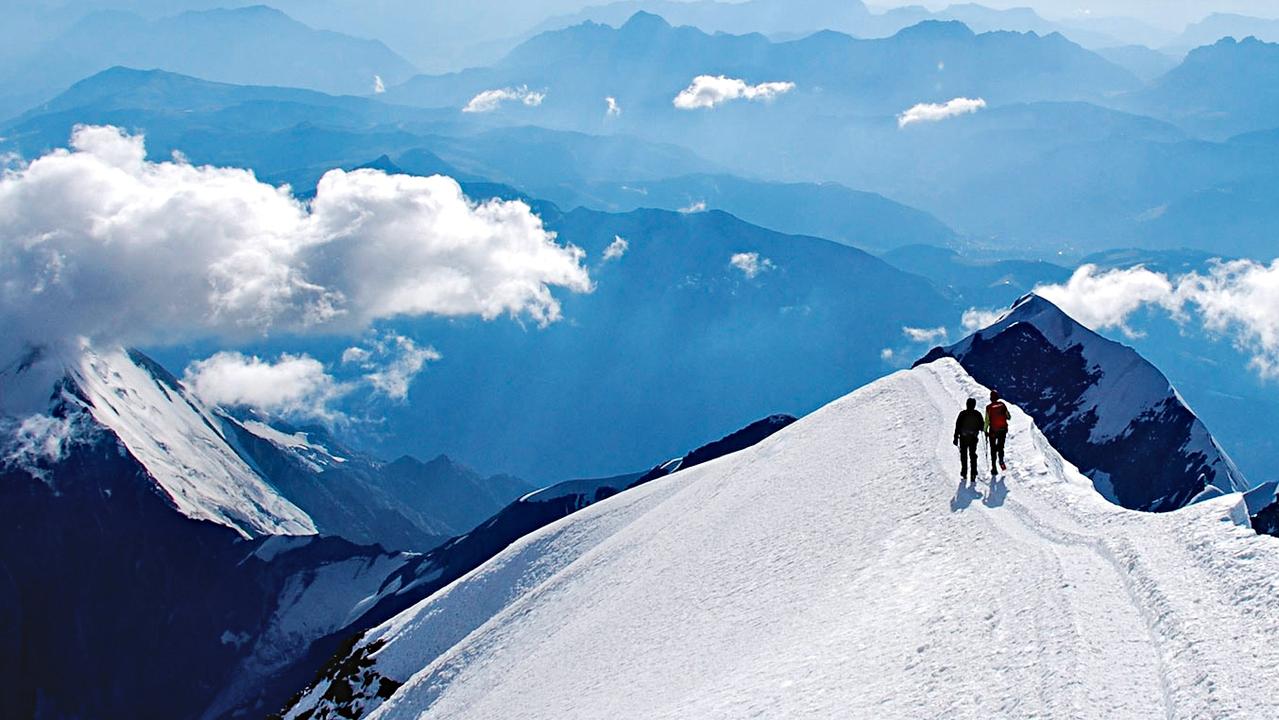Rhapsody in blue on Santorini
WHERE else but Greece's famous blue island would party-hard tourists abandon the pubs and pools to watch the sunset?

WALKING in heels isn't recommended on the island of Santorini.
Two minutes on land proves the point but tourist maps press the case in bold print, just in case.
Hotels or villas with a view of the caldera Santorini's sea filled volcanic crater usually require you to walk up and down steps; restaurants and bars are spread along the rim of a cliff and reached by pathways where uneven ground is par for the course.
Most visitors are in casual mode but there's always the odd fashion tragic tottering along.
Yet nothing in the brochures prepares you for the biggest hurdle: watching where you walk while taking in the stunning view. For Santorini, one of Greece's most famous islands, is one place that lives up to its reputation.
People come here for romance and the sun, and there's more naked flesh on show around the pools and beaches than in Miami.
But the view is the big drawcard. Where else would you find the young party crowd forgoing pubs and pools to perch on walls and stairways to watch the sunset?
The villages are sprinkled like a dusting of snow along the dark rocks of the cliff to take in the mesmerising views to sea.
Where the jagged rock falls away into the yawning depths of the caldera, the water is an intense blue, so deep the giant cruise ships that call in each day need to be tethered to buoys.
Out in the centre of the caldera slumbers the reason for its existence: the volcano. Nowadays, it's a featureless black mass of tumbled boulders that occasionally stirs and steams to remind everyone it's still there, waiting ...
About 3500 years ago, it blew its top with such force that it not only destroyed Santorini but covered the remnant with up to 60m of ash and pumice.
The resultant tsunami pulverised large swathes of Crete, 122km to the south. Vulcanologists believe the cataclysm was the largest volcanic event in European human history and the source of the legend of the lost city of Atlantis.
When Santorini collapsed into its watery heart, the sea rushed in to fill the void, leaving the crescent shaped island rimmed by cliffs on the caldera side and featureless, sun blasted slopes on the other.
Now those cliffs are worth their weight in gold, for land prices in Oia, at one tip of the crescent, and at Imerovigli towards the capital, Fira are some of the highest in Greece. Three million euros (about $5.8 million) will buy you a clifftop property on a hectare at Imerovigli today. Not bad for a village once useful only for its ability to spot pirates before they could land.
Nowadays the only marauders are the thousands of tourists who descend like locusts on the island as soon as the chill winds of winter stop trying to blow the sun umbrellas to Crete.
Every skerrick of land in the villages facing the caldera is taken up by restaurants and bars, costly hotels and villas.
To maximise space, cave rooms are chiselled into the soft volcanic rock. One villa's courtyard is the next villa's roof, with common stairs linking every villa or room.
The paths fan out like a cobweb, so it's easy to take short cuts within a village or another villa's property great for having a nosey at what neighbouring properties offer.
But if you get lost, just look down. Each villa or hotel paints its stairs and pathways a particular colour, so, like Dorothy and the yellow brick road, all you need do on Santorini is follow the grey, the blue, the brown or the beige.
Amazingly, you never see them scuffed or dirty. Despite most buildings and borders being white, and the soil dark, offending scuff marks are instantly painted over.
Staff at our Imerovigli hotel, On The Rocks, were so immaculate we took bets on when these Greek Adonises would break into a sweat or crease their pristine whites.
Every day they lugged heavy bags up and down stairs on their shoulders; every breakfast they delivered a groaning tray laden with boiled eggs, chef's surprise flan, sweet rolls, fresh brewed coffee, fruit and yoghurt down a flight of stairs from the little kitchen near the pool to our veranda table.
To our left and right, we could see couples from different hotels being served similar fare, so a long, lingering breakfast with a view is obviously a Santorini signature.
Our room, chiselled out of rock, with rough hewn, painted walls and a roof doubling as a sun terrace for the pool, owed more to the Flintstones than Romancing The Stone. The mattress was high on a flat, blue painted rock, reached by three steps.
Across the stairway, our friends had a classic room, all pretty blue and white checks and gilt mirrors, but with the same large veranda for hours of caldera viewing.
Each room is different so check with reception when booking, in case you can't handle stairs or prefer a particular decor.
Although it's rarely mentioned, all this expensive real estate is dependent on the volcano out in the middle.
If you stand at the furthest point of Imerovigli looking back towards Fira, the blackened, yawning shells of abandoned cave rooms from before the last big quake, in 1956, are clearly visible.
Oia pronounced E ah suffered the same fate in'56 but has been rebuilt to be more beautiful than ever. The pink, maize, pale aqua, salmon and ubiquitous white walls are set off by the splash of crimson bougainvillea or the blue domes of its churches.
Oia's claim to fame is its romantic location facing the sunset, but there's more to this exquisite village than its honeymoon hotels. It's also an artisan hub, full of gorgeous little shops selling jewellery, paintings, scarves and carvings, and makes Fira, with its many gold jewellery stores and souvenir shops catering for the cruise ships, look almost tacky.
Cheap T shirts, postcards and snow domes aside, each of the villages has its charms.
Fira has a maze of streets to explore, museums, bookstores, churches and bars. The shopping and restaurants can be chaotic, with constant entreaties to come inside and spend! Imerovigli is quieter, with restaurants and a few shops catering for residents.
Oia is built up and busy, but its maze of little streets and stairs lead to hidden bars, galleries and restaurants.
A tip for sunset viewing: Everyone heads to the top, so walk or taxi down to the fishing port at Ammoudi, where the little fish tavernas do a brisk trade in fairly expensive but good seafood and you won't be rushed through.
Sunday Mail (SA)



